![]()
Category: MCRFB The ’50s
’50S: JOCKS SHOWCASING NEW TALENT FOR ’57 . . . JANUARY 26, 1957
From the MCRFB news archives:
Foresight and backing puts Presley, Perkins, Little Richard, Teenagers on the charts
Many R&B and C&W artists hit pop pictures in ’56 via deejay push and savvy
B y B I L L S I M O N | B i l l b o a r d , J a n u a r y 2 6 , 1 9 5 7
NEW YORK — As long as there are disk jockeys who are ready, willing and able to spot new talent and showcase it, the record business will remain fresh, vital, interesting and unpredictable. This was borne out dramatically in 1956, the year which saw the arrival on The Best Selling Charts of such new and by now established pop stars as Elvis Presley, Carl Perkins, Little Richard, The Teenagers and many others.
The dominant fact in the 1956 picture, and here again, it’s the deejays who can take much of the credit, was the emergence on the pop charts of many artists who previously had been thought of as only Rhythm and Blues, or as country and western sellers.
But taking first things first, it was in The Billboard of March 10, 1956, that both Elvis Presley and Carl Perkins made their debut on the pop charts. Presley, with his first RCA platter, “Heartbreak Hotel,” and Perkins with his all-market hit, “Blue Suede Shoes,” was another cut for Presley’s erstwhile employer, Sun Records of Memphis.
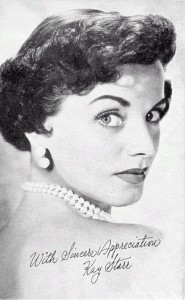
Perkins unfortunately landed in a hospital following an auto accident, but Presley went to produce hit after hit for every category of in the charts. Most of these are still selling and, for the record, these are the titles that made the pop list: “Don’t Be Cruel,” “Hound Dog,” “I Want You, I Need You, I Love You,” “Love Me Tender” and even two numbers which had been released only as tracks from extended-play albums, “Love Me” and “Blue Suede Shoes.”
Sun Records also produced a pop hit by Country and Western artist Johnny Cash, “I Walk The Line.”
Actually, this resurgence of country talent in the pop play area was a part of the whole so-called “rock and roll” surge in all fields and gave rise to the term “rockabilly,”applicable to country artists who performed blues tunes and other material back by the “Big Beat.” Capitol Records came up with Gene Vincent and “Be-Bop-A-Lu-La,” and Vincent provided more good program material in his Capitol LP which followed. Jim Lowe, a pop-artist writer with C&W roots who had come close in several previous attempts, finally click in all categories with “Green Door.” Lowe, a deejay himself on WCBS, New York, got hefty support himself from his spinner colleagues throughout the country.
While not exactly in the same rockabilly mode, but still not remotely urbane, there was the novelty vendor called Nervous Norvus on Dot Records. Norvus “Transfusion” made a lot of noise literally an figuratively, and the artist was able to follow up that unusual entry with “Ape Call,” who enjoyed lesser but still chartworthy success.
R&B Invasion

The most numerous invasion force, however, came right out of the pure area of rhythm and blues. As the adulterated product known as rock and roll caught on, the deejays led the kids in the appreciation of the true, original article. This led to the pop success of such performers as Little Richard, the Teenagers and many more.
Running down the impressive list, Specialty’s own Little Richard, an established R&B seller, cracked the pop barrier first with “Tutti Frutti,” despite very heavy cover competition cover by Pat Boone. Richard was then able to follow-up, and this time to outstrip the competition, with “Long Tall Sally” and the coupling of “Rip It Up,” followed by “Ready Teddy.” The same happened with that group of youngsters on Gee Records, appropriately named the Teenagers, starring pint-sized Frankie Lyman. The group broke into the all-market money with “Why Do Fools Fall In Love?” and was able to follow the same route with “I Want You To Be My Girl.”
Not all of the R&B groups were able to repeat on the pop lists after that first breakthrough, although some of those one-shots were substantial hits. For example, we had the Teen Queens with “Eddie My Love,” the Cadillacs with “Speedo,” the Six Teens with “A Casual Look,” and Little Willie John with “Fever.” Although these acts didn’t repeat, they did open the door to acceptance of any of their future releases which may merit broad pop exposure.Their efforts will not be lightly dismissed.
Break precedent
There also were the unprecedented occurrence of two out-and-out R&B versions of the same tune making the pop chart. This was “Stranded In The Jungle,” cut originally by the Jayhawks, but covered by the Cadets, who outdistanced the original, although both versions made it. And there was an out-and-out pop styling of “Treasure Of Love” by Clyde McPhatter, a balladeer whose previous hits had all been in the R&B classification.
Rock and roll, which now is identified virtually as a distant idiom, produced its own share of new chart artists. Mercury employed the Diamonds to cover a number of hits of R&B origin and several of these hit right on the money. First was a cover for the Teenagers’ “Why Do Fools Fall In Love?” and the second was “Church Bell May Ring,” which is believed to have outsold the original by the Willows. Other new faces were Gloria Mann with “Teenage Prayer,” the Bonnie Sisters with “Cry Baby” and Bobby Scott with “Chain Gang.”
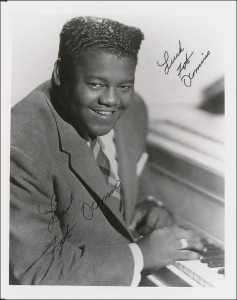
“Ivory Tower” carried two new names to the charts. Cathy Carr made it for Fraternity Records first big disk and Otis Williams made it for King. Film was the vehicle to chart prominence for one Elmer Bernstein, the film conductor responsible for the sound-track version of “The Man With The Golden Arm” music and for Dick Jacobs, who covered. It also did the trick for veteran batoneer Morris Stoloff, with his combination of “Moonglow” and “The Picnic Theme.” Coral Records’ own George Cates cashed in heavily with his cover of the contrapuntal concoction. A number of similar productions by the same artists fell short, however, and Johann Sebastian Bach’s eminence in the field of polyphony weathered the challenges well.
Andy Williams, young vocal and the star of the Steve Allen TV shows, rode in with the first vocal version of Eddie Heywood’s “Canadian Sunset,” and jocks gave a good listen to his “Baby Doll” follow-up, which has yet to break through, however. The Rover Boys established what could be a seasonal perennial in “Graduation Day.” Then there was the unusual French-language smash by the Blue Stars called “Lullabye Of Birdland.” This version broke through where a flock of English-language and instrumental versions had failed. The break-through was due to heavy deejay support, incidentally.
Cole Porter with his rendition of “True Love,” from the big flick, “High Society,” carried in a veteran film vocalist, Jane Powell, although the top version was by Bing Crosby and another chart (and disk) newcomer, Her Serene Highness, Princess Grace of Monaco.
This isn’t the whole story by any means. Jocks and record buyers went for an occasional instrumental change of pace. Of most recent memory are Bill Doggett with his blues rocker, “Honkey Tonk,” and Sil Austin with his “Slow Walk.” Doggett also did okay with with a cover of the second-named. END.
(Information and news source: Billboard; January 27, 1957).

![]()
’50s: BILL HALEY COMETS DANCE HALL HOT . . . DECEMBER 11, 1954
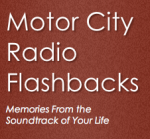 From the MCRFB news archives: 1954
From the MCRFB news archives: 1954
HALEY COMETS RACK BIG GROSSES THROUGHOUT YEAR
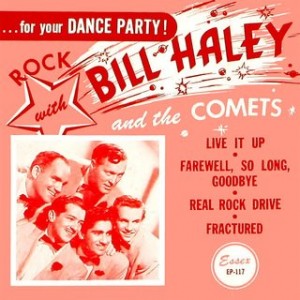 NEW YORK — Record popularity enjoyed by Bill Haley and His Comets on Decca disks has boomed the sextet into the top money-making bracket, according to Jolly Joyce, head of the Jolly Joyce Theatrical Agency here, which holds the booking exclusively for the musical unit.
NEW YORK — Record popularity enjoyed by Bill Haley and His Comets on Decca disks has boomed the sextet into the top money-making bracket, according to Jolly Joyce, head of the Jolly Joyce Theatrical Agency here, which holds the booking exclusively for the musical unit.
Before locating for December at Andy’s Log Cabin in Gloucester, New Jersey, the Joyce agency had the Haley Comets take in a full week of one-nighters. And with combination of percentages and guarantees, they netted well over $5,000 for the past week.
Much of the take came from a record one-nighter at the Valencia Theater in Baltimore, promoted by Buddy Deane, disk jockey on WITH and Jim Ferguson, Haley’s personal manager.
Giving two solo concerts Saturday night, November 27, at a $1.25 top, tax included, the 1,600 seat house was overflowing for the two evening shows. Promoters reported 3,300 tickets sold to make it a sell-out three days in advance, with more than 1,000 turned away at the box-office. The gate was over $4,000 and the Haley Comets came away with a net of $2,040 for the evenings’ work. END.
(Information and news source: Billboard; December 11, 1954).
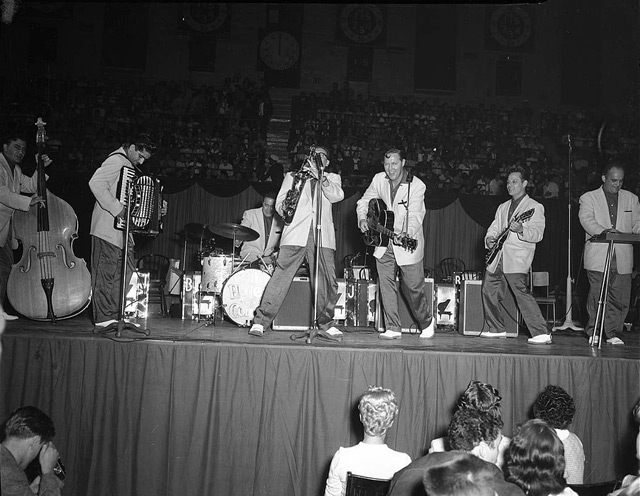
![]()


